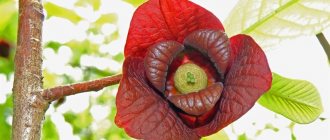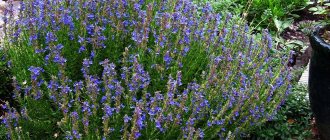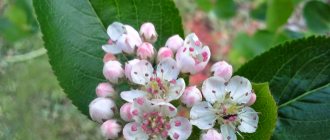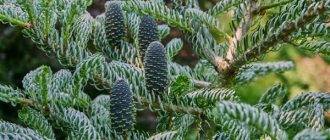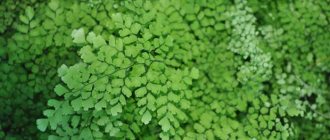The genus hazel or hazel unites several dozen species of deciduous shrubs and trees of the Birch family. Most of them are distributed in the temperate climate zone of Eurasia and North America. They are found on the edges, as part of the undergrowth of mixed and deciduous forests. The main value of hazel is its fruits. Some species are used in folk medicine and are raw materials for industrial wood.
Botanical description
Hazel is often a densely branched bush with dark gray wrinkled bark and a broad, ovoid, dense crown. Less commonly, a small tree up to 6–8 m high. Young shoots are yellowish-brown, skeletal branches are long and flexible. The root system is voluminous, powerful, with numerous lateral appendages. Most of them are concentrated near the surface.
Hazel leaves are simple petiolate, bright green, slightly wrinkled, with slight pubescence . The plates are 5–12 cm in size, broadly oval, heart-shaped at the base, with jagged edges and pointed apices. The surface has pronounced feathery veins and is noticeably lighter on the underside. They bloom in early May.
Inflorescences are dioecious . Men's - in the form of dangling cylindrical earrings of a yellowish-green color. They are laid in the autumn and bloom 1–2 weeks before the leaves appear. The female ones are located in pairs in axils-bracts, have the appearance of short thick buds with red threads of stigmas.
The fruits ripen in September or late autumn . Hazel nuts have a round shape, the light-colored seed is surrounded by a dense, woody shell-pericarp of a yellowish or brown hue. Each nut is enclosed in a dense light green tubular shell with open cut edges - a plus. In several fruits, their bases usually grow together, forming a fruit cluster of 2–5 pieces. When the hazel ripens, the plume dries out and the fruits freely fall out of it. Hazel bears fruit from the age of 5–7 years.
The walnut tree is light-loving, moisture-loving, and sensitive to soil fertility . On poor or sandy soils it develops slowly. Hazel productivity is uneven. Usually, after 1–3 years of abundant fruiting, while maintaining the same weather conditions, a period of dormancy follows: there are very few nuts or no nuts at all.
Hazel trimming
Hazel can be trimmed in winter. But it is best to do this in spring, at the late stage of flowering. The fact is that during flowering the plant will shake during the pruning process, which will have an extremely beneficial effect on the efficiency of pollination.
Pruning rules
Hazel can be cultivated as a tree on a trunk, the height of which can vary from 0.35 to 0.4 m. However, a hazel tree shaped like a bush is easier and more convenient to care for. 7 days after planting the seedling in the garden, it should be shortened to 0.25–0.3 m. During the summer period, shoots will grow on the bush, which should not be removed; it must be remembered that hazelnut fruiting is observed on one-year-old wood. With the onset of spring, you need to start shaping the bush. All shoots except the 10 most powerful ones must be removed. The remaining shoots should grow from the center of the bush in different directions at a distance from each other.
All injured, competing, diseased, weak and deformed stems should be pruned. Make sure that the bush does not thicken. In the fourth year after planting the seedling in the soil, it will begin to bear fruit. At this time, it is imperative to carry out both thinning and sanitary pruning of the bush in a timely manner. When the age of the tree reaches 18–20 years, its yield begins to fall; to prevent this, they resort to rejuvenating pruning. Every year, 2 or 3 old trunks must be cut out into a stump, and they must be replaced with the same number of basal shoots, which should grow fairly close to the center of the bush. Young skeletal branches need to be shortened slightly, as this helps stimulate the growth of lateral shoots on them.
If you grow a hollow in the form of a tree, then 7 days after planting the seedling in open ground, all its stems should be removed, only the trunk should remain. As soon as new stems appear, you will need to trim those that are located at the bottom of the trunk. And in its upper part it is necessary to form 4 or 5 skeletal branches. Remember that it is very important to cut out all root shoots in a timely manner.
Hazelnut pruning 02/21/2021 Batkiv Garden
Classification
In total, there are almost 20 types of hazel, differing in shape, size and taste of the fruit. Among them there are both wild and selected varieties, as well as hybrids.
Ordinary
The most common species in Europe . In central Russia it is found everywhere. A tall, dense shrub with grayish-brown bark and a spreading crown. The leaves are alternate, large, dark green. Young shoots and the underside of the leaves are pubescent. In the subtropics the plant blooms at the end of February, in the temperate zone - at the end of April. The nuts are 1.5–2 cm in size, round or oblong, with a light brown shell. Plus with deeply cut edges.
Manchurian
Far Eastern shade-tolerant and frost-resistant species. Multi-stemmed shrub up to 4–5 m high with a spreading crown. Young shoots are brown, with slight pubescence . The bark is dark gray, with cracks. The leaves are dark green, narrower than those of common hazel. The nuts are elongated, 2–2.5 cm in size, the fruit shell is hard and spiny.
Variegated
A frost-resistant type of hazel, common in Siberia and the Far East. A shrub up to 2–3 m high with a dense, very wide and dense crown. The bark of adult shoots is dark brown. The leaves are coarsely toothed, heart-shaped at the base, and wide . In spring, young foliage has a reddish tint, in summer it becomes bright green, and in autumn it turns lemon yellow or orange. The nuts of multileaf hazel are yellow, round, slightly flattened, 1.5–3 cm in diameter.
Tree-like
It has a second name: bear hazel or bear nut. One of the largest types of hazel. It is a slender, straight-trunked tree up to 20–25 m high. The bark is light gray, peeling off in plates in adult specimens . The crowns are of a regular pyramidal shape, the leaves are petiolate, oval, serrated, pointed. The nuts are 2.5–3 cm in size, covered with an elongated pinnately dissected plush of a light green hue. In nature, tree hazel is found in Transcaucasia, Asia Minor, and the Balkan Peninsula.
Lombard nut
The ancestor of industrial varieties of fruit crops. Distributed in southern Europe, Asia Minor, North America. Shrub up to 7–9 m high with a densely branched crown. The bark is dark gray, covered with deep cracks. The leaves are large, oval, slightly lobed, toothed, 10–12 cm long, 5–7 cm wide. Many varieties have violet or purple foliage . The fruits, up to 3 cm in size, are surrounded by a dense fleshy plus, dissected at the edges. The nuts have a high taste and are larger than other types of hazel.
Varieties of hazelnuts
There are more than 20 species in the hazelnut genus. The diversity of cultures of this kind is simply amazing. Plants have significant differences, but almost all tolerate frost well and are distinguished by their longevity.
Hazel grows well in any type of soil; it is unpretentious, but it is better to bear fruit in fertile soil. The nut loves moisture, but its excess can harm the plant. In an open, sunny area, hazel will be decoratively attractive and produce a good harvest. Among all the types of hazel, there are several of the most common.
Common hazel, or hazelnut
The common hazel variety reaches a height of 6 m. The tree has an extremely attractive crown. What distinguishes common hazel from classical varieties is its flowering, which begins before the leaves bloom. Bees are especially interested in this shrub.
Note! When other trees are just beginning to prepare to bloom, hazel is already in full bloom and provides nectar to insects.
Bear nut, or tree hazel
Bear nut, or tree hazel, stands apart among all types of wild hazel. This plant grows up to 20 m high. The diameter of the walnut crown is 8 m. The slender and attractive trunk is a distinctive feature. The tree is recognized by its wide pyramidal crown shape. During the season it gives a big increase. The plant tolerates drought, shaded areas and frost well.
Application
Hazel is a fruit plant. Nuts of most types are a nutritious product and are used in cooking. The content of biochemically active substances determines the pharmacological value of the fruit. Along with them, preparations from other parts of the plant are beneficial for health: leaves, flowers, bark and roots. The wood of large species is of industrial interest .
Wood
Hazel belongs to the sapwood species. This is a uniform yellowish, pink or light brown material with a discreet texture. It is characterized by moderate strength, resistance to warping, does not dry out or chip under impact loads. Walnut is tough, can be easily processed with all types of hand and mechanical tools, bent, glued, etched and sanded. Due to the small diameter of logs, they are almost never used in construction. Areas of application of hazel:
- furniture industry;
- production of veneer, finishing panels, floor coverings;
- carpentry and turning products, cutting boards, tool handles, fittings, eco-friendly tableware;
- souvenirs.
Flexible walnut shoots are used for weaving baskets, wooden fences, and making hoops and fishing rods.
Medicine
Hazel fruits contain fatty oil, vitamins D, E, group B, organic acids, glycosides, calcium, potassium, iron, cobalt and other minerals. Essential oils, alkaloids, tannins, flavonoids and other biochemically active compounds were found in the leaves, flowers and other parts of the plant. Preparations based on nut pulp, bark and root powder, flowers and leaves have versatile therapeutic effects:
- antipyretic;
- anti-inflammatory;
- antimicrobial;
- anticancer;
- immunomodulatory;
- blood purifying;
- vasodilator;
- anthelmintic.
Tinctures and teas are used to treat gastrointestinal diseases, fever, bronchitis, pneumonia, nervous disorders, and headaches.
Properties of hazel: its harm and benefits
Hazel is a shrub or plant that brings not only benefits, but also harm.
Useful qualities
The hazelnut kernel contains many substances beneficial to human health, ranging from vitamins A, E, C and PP, including amino acids and ending with the following elements of the periodic table:
- potassium
- manganese
- fluorine
- copper
- magnesium
- calcium
- iodine
- iron
Of the beneficial qualities of the hazelnut kernel, it is worth highlighting:
- has a positive effect on memory and attention;
- promotes normal functioning of the cardiovascular system;
- accelerates metabolism and strengthens the body's immune system;
- helps rehabilitation after illness;
- indicated for epilepsy, anemia, measles, rheumatism, allergies, etc.
Contraindications
The nuclei can cause exacerbation of skin diseases, for example, neurodermatitis. Hazelnuts are contraindicated if you have symptoms of psoriasis. An infusion made from hazel bark and its leaves increases a person’s blood pressure. This should be taken into account by people suffering from hypertension.
Hazelnuts and hazel
Hazelnuts and regular forest nuts are closely related products. The first species combines several cultural forms originating from the Lombard nut. They are slightly larger than the others, have a brighter and richer taste, and contain more fatty oil, amino acids, minerals and vitamins than wild hazel.
Benefit
In terms of their saturation with nutrients, micro- and macroelements, organic acids, and vitamins, hazel nuts are superior to many food products. These fruits are easily digestible, and they contain enough protein and fat to serve as a substitute for meat or milk. To provide the body with all the beneficial substances it needs, it is enough to consume about 150 g of nuts per day. It is necessary to introduce them into the diet in case of physical or nervous exhaustion, chronic intestinal diseases, decreased vision, insufficient immunity, lactase or gluten intolerance.
Hazel rarely causes allergies and is suitable for feeding children, elderly and weakened people, and pregnant women.
Harm
Obese people should not overuse nuts. This is a very high-calorie product. 100 g of peeled kernels contain almost 500 kcal. It is necessary to include them in the diet if you are overweight on a limited basis - no more than 50 g per day.
Hazel fruits can be harmful in cases of chronic cholecystitis, pancreatitis and some forms of gastritis - the body requires a large amount of enzymes to digest nuts. Individual intolerance may also become an obstacle to their use.
Hazel propagation
Hazel tree reproduces:
- dividing the bush
- cuttings
- vaccination
- offspring
- bends
- seeds
Let us briefly consider the most popular methods of propagating the Corylus avellana plant.
Reproduction by taps
This method is simple, but requires significant costs. The order of its stages is presented below.
- Before the start of sap flow, in April or October, annual low-growing shoots are bent to the surface of the earth and placed in pre-dug furrows, the depth of which is 10-15 centimeters. The top remaining above the ground is shortened. If necessary, the branch is fixed with a wooden bracket.
- New vertical shoots appear from the buds located on the branch, which, as they grow, must be hilled up to the middle, and the leaves located on the lower part must be removed.
- The shoots will take root. Thus, in a year, the gardener will receive several seedlings from the allotment. Before they are planted in another place, they will need to be nursed for 1-2 years.
New bushes are obtained from vertically oriented cuttings. For this purpose, the stumps of large branches of hazel tree, which remain after the spring pruning procedure, are covered at a height of approximately 50 centimeters with a transparent film to stimulate the awakening of still dormant buds.
After making sure that the new shoots have reached 15 centimeters in length, the gardener needs to cover the water with a layer of plant humus no more than 5 centimeters thick. After waiting until the young hazelnut tree reaches a height of 35 centimeters, the film will need to be removed, and in the summer it will need to be watered. With the arrival of autumn, the cuttings are carefully dug up and divided into rooted shoots at the place of the bandage.
Reproduction by offspring
This is how tree hazel reproduces in the natural environment. The formation of the first offspring takes 1-2 years from the moment of planting. They are located at a distance of 50-100 centimeters from the trunk.
The offspring are planted - the so-called tear-offs - at two to three years of age. Using an ax, they are split off from the rhizome, then transplanted into a deep pot for growing. Such scions can be planted immediately in the permanent place provided for in the placement plan. But experienced gardeners recommend in this case to place at least 2 shoots, and even better, 3, in one previously prepared hole.
Reproduction by grafting
The best seedling for the Corylus avellana species is bear nut. The reason is that it does not produce offspring. Wild hazel can also be used.
Hazelnut is grafted:
- in the spring - in a split or by grasping the bark;
- in summer - by budding method.
For this purpose, the following actions are performed:
- For cuttings, the apical part of the branch or the middle is harvested. Cutting is carried out in the winter season, and stored until the onset of snow. if weather conditions permit, or in the refrigerator.
- Vaccination is carried out in April-May, that is, when the period of most active sap flow is observed.
- The handle must be sharpened on both sides. A split is made in the rootstock and a scion is inserted into it. The area is insulated with plastic film, and open areas must be covered with garden pitch.
The ease of grafting into clefts is offset by lower survival rates compared to budding.
Reproduction by dividing the bush
Experienced gardeners recommend performing this procedure in the autumn season. It includes the following stages:
- A young hazelnut or hazelnut bush needs to be dug up, and then several parts should be formed by cutting it. In this case, the roots should remain on each fragment. It is also necessary to ensure that their length is 10.....15 centimeters.
- The cuts must be sprinkled with coal.
- Fragments of hazel are planted in different holes.
Landing
A walnut tree is easy to grow in your own garden. If breeding a crop is planned for fruit production, it is recommended to plant several specimens at once for successful cross-pollination.
The hazel tree should be placed in a well-lit area, maintaining a distance between trees of about 3–4 m . Work to be carried out in the fall. It is useful to dig up the soil in advance, adding 3–4 kg of humus or ½ bucket of rotted manure per 1 m². The holes for seedlings are prepared with a depth and width of 65–80 cm. Drainage made of stones or broken bricks is placed at the bottom - a layer of about 10 cm. Pour a bucket of a mixture of equal parts of garden soil, humus, 200 g of wood ash and 20 g of complex nitrogen-phosphorus fertilizer on top. Pour out 10 liters of water. Then the seedling is placed in the hole, tightly covering the roots with soil on all sides. There should be no gaps between them. The root collar should protrude 1–2 cm above the surface. Upon completion of planting, the plants are watered again. It is useful to mulch tree trunk circles with peat immediately after planting.
What are hazelnuts
The described culture is most often found in the form of shrubs that grow up to 4 m in height. They are used not only to obtain nuts, but also to decorate the site.
Tree varieties of the described plant are capable of reaching a height of up to 10 m. If favorable conditions are created for this crop, then the duration of its life cycle can be 100 years, 80 of which the plant will bear fruit.
Important! Hazelnuts should not be planted in lowlands and on slopes - this can cause the plant to freeze during frosts; also avoid planting in places with high groundwater levels, which erode the soil under the rhizome of the crop, which leads to its rotting.
Care
The requirements for caring for hazel trees are traditional . The shrub needs regular moistening, loosening the soil, removing weeds and fertilizers.
Hazel needs to be watered abundantly . In dry or hot weather, bushes require 10–15 liters of water every week, from April to September. You can refuse additional moisture only if there is a large amount of natural precipitation. Adult bushes are watered less often: 1–2 times a month.
The hazel tree is fed three times a season . In April or May, 20 g of nitroammophoska is added to the soil. Early summer: 200 g of ash mixed with 10 g of superphosphate and 10 g of potassium salt. At the end of July, it is advisable to add 20 g of superphosphate. It is useful to water poor soils from time to time with a solution of manure or add compost.
Every year hazel needs sanitary pruning . It is necessary to remove branches that are drying out, diseased or growing incorrectly. Old shrubs that have reached 20 years of age can be rejuvenated by cutting off most of the shoots, leaving only 10-centimeter shoots with several growth buds.
Hazel care
Growing conditions
Planting and caring for hazel is not labor-intensive, and if you sow mustard, lupine or vetch with oats in the trunk circle of the bush to use them as mulch after mowing, then you will have even less trouble. You can keep the soil under the hazel under black fallow, loosening it from time to time to a depth of 4-7 cm and clearing it of weeds. In addition, you will have to constantly fight with the root shoots, and it is better to do this while the shoots are still weak. Each root shoot needs to be dug up and cut off at the place where it extends from the root. Cuts on the roots are treated with crushed coal.
Watering
Hazel tree care includes watering the plant. Seedlings begin to be watered within a week after planting. Lack of moisture can adversely affect the formation of flower buds and the ripening of hazel fruits. During the growing season, the soil under the hazel tree needs to be watered 5-6 times, spending 6-8 buckets per adult bush. In dry summers, you can moisten the hazel tree more often - it loves water very much. But in the rainy season, you don’t have to think about watering the hazel tree. On average, hazel is watered once a month. Water is poured into the tree trunk circle in portions so that it does not stand as a puddle, but is absorbed. The next day after watering or rain, it is advisable to loosen the soil in the tree trunk circle.
Top dressing
Growing hazel involves applying fertilizer to the tree trunk. In the fall, the hazel tree is fed with potassium and phosphorus: once every 2-3 years, 3-4 kg of manure, 20-30 g of potassium salt and 50 g of superphosphate are applied to each bush. And in the spring, the hazel tree will need nitrogen fertilizer, for example, ammonium nitrate or urea: as soon as the buds swell, apply 20-30 g of fertilizer to the tree trunk circle. The hazel tree also needs nitrogen fertilization in July so that the fruits ripen at the same time. It is advisable to feed young plants with organic matter in the form of compost or rotted manure - it is enough to apply them every 2-3 years in the amount of 10 kg per hazel bush.
Care during flowering
An indicator of the successful development of hazel is its flowering. When does the hazel tree bloom? Flowering occurs in April, even before the leaves appear on the bush. When the air temperature rises to 12 ºC, hazel catkins grow and add 3 cm per day, and the drier the air, the faster they lengthen, and when the catkins reach a length of 10 cm, they become loose and begin to scatter pollen. This pollination lasts from 4 to 12 days, while the female flowers open for two weeks. Female flowers catch pollen from male flowers either from their own or from a neighboring hazel tree. That is why it is better to grow at least three hazel bushes in one area.
Hazel propagation
Hazel propagates by seeds, layering, suckers, grafting, cuttings and dividing the bush. The seed propagation method is used mainly to perform breeding tasks - it allows you to obtain new varieties adapted to certain climatic conditions. However, in amateur gardening, the generative method of hazel propagation does not justify the time and effort spent, since at best, only one seedling out of a thousand reproduces the varietal properties of the parent plants. To preserve varietal qualities, they resort to vegetative propagation methods, which we will describe below.
To propagate hazel by horizontal layering, you need to bend low-growing annual hazel branches to the ground in early spring or late autumn, place them in furrows 10-15 cm deep, secure and slightly shorten the top remaining above the surface. There is no need to fill the furrows with soil. Vertical shoots begin to grow from the buds on the branches, which should be hilled several times to the middle, tearing off the hazel leaves from the bottom of the shoots. Gradually, the shoots will take root, and you will have a large number of seedlings that need to be grown for 1-2 years before planting in a permanent place.
- Levkoy: planting and care in open ground
According to the same principle, hazel is propagated by arc layering: in the spring, the branches are bent in an arc, the bark on the part of the branch touching the soil is cut, the branch is fixed in a hole 20-30 cm deep, the hole is filled up, but so that the tip of the shoot remains on the surface - it is tied to a peg . The rooted cuttings are separated from the mother plant in the fall, dug up and grown for 1-2 years before being planted in a permanent place.
Growing peanuts - planting and gardening
Propagation of hazel trees by vertical layering is also a very simple procedure: after rejuvenating spring pruning, the stumps of large branches are hermetically covered with film at a height of 50 cm in order to awaken dormant buds to growth. When the shoots begin to grow and they reach a height of 15 cm, they are covered with humus to a height of 4-5 cm, having previously tied them at the very bottom with soft wire. When the length of the shoots becomes 20-25 cm, they are hilled with humus to a height of 8-12 cm, and when the shoots reach 30-35 cm, they are earthed up at a height of 20 cm and mulched. After the third hilling, the film is removed. The bush is watered and weeded all summer. Hazel leaves at the bottom of the shoots are removed before each hilling. In the fall, the soil is carefully raked so as not to damage the adventitious roots and well-rooted shoots are broken off at the site of the constriction. Weakly rooted shoots do not need to be separated.
The growth of hazel shoots occurs in a diameter of 1 m from the trunks. Offshoots are formed in the second or third year after planting from dormant buds on the roots and emerge from the ground at a distance from the bush. For reproduction, offspring 2-3 years old growing on the periphery are used - they are called peelings. The cuttings are separated from the rhizome with an ax and planted for growing into a school. You can plant them immediately in a permanent place by placing 2-3 peels in one hole.
When propagating hazel by grafting, you can use wild hazel seedlings as a rootstock, but the best rootstock is a bear nut seedling, which does not produce offspring. Hazel trees are grafted in the summer using budding with a sprouting eye or in the spring by cuttings into the butt, into a splinter or behind the bark. Cuttings for scions are suitable for apical ones or they are cut from the middle part of the shoots. Cuttings are prepared in winter and stored until spring in the refrigerator or in the snow.
It is also easy to propagate hazel by dividing the bush. The dug up bush must be divided into parts so that each of them has roots 15-20 cm long. After treating the sections with crushed coal, the sections are planted in pre-prepared holes.
Wintering hazel
Young plants are wrapped in spunbond or lutrasil for the first 2-3 winters. Some gardeners prefer to bend young bushes to the ground and cover them with spruce branches, and then cover them with snow to protect the shoots from freezing or breaking off. Adult plants overwinter normally without shelter.
Reproduction
Hazel should not be propagated by seeds . This method does not make it possible to preserve the varietal characteristics of the plant. The main methods are vegetative.
Young hazel trees can be propagated using green cuttings, cutting off shoots that have not yet become lignified in the summer. For rooting, take pieces 12–15 cm long with a pair of leaves. The material is planted in greenhouses - in a mixture of garden soil and peat, kept at a temperature of +20–25 °C, and watered daily. By autumn they receive the finished material.
Adult bushes are propagated by layering . In spring, the side shoots are cut and pinned to the ground, sprinkled with soil. They are looked after during the season. After 1.5–2 months, the cuttings take root, and new shoots come up from them. In the fall they are dug up and cut off from the donor.
By dividing the bush, old specimens in need of renewal are propagated . In September, the hazel tree is dug up, the above-ground part is shortened, the roots are washed and cut into several parts with healthy growing points. The cuttings are immediately planted in the ground.
Variegated hazel
A shrub reaching three meters in height, with a dense, spreading crown. Variegated hazel got its name due to the change in color shades of foliage during one growing season. The leaves are of an unusual shape, wide, obovate with three teeth at the top when blooming, have a terracotta hue, in the summer - rich dark green tones, and a golden-orange palette envelops the hazel in the fall. Variegated hazel perfectly tolerates even severe drought, is frost-resistant, and is characterized by very early fruiting. The species is light-loving, but tolerates some shading calmly. It has become widespread in eastern Siberia, Asia, and the Far Eastern regions of Russia. It is found in the undergrowth of mixed and pine forests, as well as on forest edges, clearings, and on hillsides, forming impenetrable thickets.
Harvesting
The age of hazel fruiting depends on the variety. Cultivated varieties bear fruit from the age of 5-6 years, wild varieties - from the age of 7-8 years. One mature tree produces from 2 to 9 kg of nuts per season. They are collected from the end of September, plucking them from branches or picking up those that have already fallen . Ripe nuts need to be air dried before use. Their fruit shell oxidizes, becomes brittle, the kernel loses some moisture and acquires a richer taste. Store the fruits in a dark, dry place, placing them in paper bags or linen bags. Airtight packaging is undesirable as it leads to mold growth.
Planting hazel in the garden
Obtaining a generous harvest involves developing and growing a scheme for placing hazelnut seedlings at the preliminary stage. It should be taken into account that when several trees are planted side by side in garden conditions, cross-pollination occurs naturally. Where do the hazel trees grow on the property and where do the hazelnuts grow? It is recommended to plant hazelnuts and hazelnuts along the boundaries of the land plot.
What time to plant
Planting Corylus avellana seedlings is allowed both in spring and autumn. But experienced gardeners advise doing this in the fall, when the soil has not yet cooled down - somewhere in early October.
Planting hazel in autumn
For planting it is necessary to select the following hazel seedlings:
- having a well-developed root system;
- on which at least 3-4 strong shoots grow. The diameter of each should be at least one to one and a half centimeters;
- There should be no leaves on the seedlings.
When several hazelnut and hazelnut bushes are planted, their distance in a row should be about 4 - 5 meters, when the row spacing is about 6 meters.
The pits are prepared a month before the planned planting date. During this period of time, the soil will not only settle, but will also have time to become sufficiently compacted. If the soil in the plot is poor, then the diameter of the holes and their depth should exceed 80 centimeters. When planting hazelnuts and hazelnuts in an area with fertile soil, the holes can be 50 centimeters deep and the same in diameter.
Before planting seedlings in the fall, you need to prepare a fertile mixture and fill the holes with it. The ingredients and consistency of the mixture are as follows:
- topsoil;
- rotted manure – 15 kg;
- 200 grams of superphosphate. If such an ingredient is not available, you can add 2 cups of completely burnt wood ash instead.
Hazel leaves in autumn photo.
This point is very important: when planting common hazel in natural conditions, its root system must be immersed for some time in a mash, the components of which are clay and manure.
A Corylus avellana seedling is placed on a small hill previously created in the center of the hole. Here a certain requirement must be met. It is formulated as follows: a hazel tree seedling, after the embedding is completed, should be positioned so that the neck of the root is about 5 centimeters above the ground level. Having filled the hole and compacted the soil, the gardener needs to drive a peg nearby and tie it up the seedling itself goes to it.
Then the newly planted hazel tree should be watered with three to five buckets of water. After letting it soak in, you will need to mulch the tree trunk circle with a layer of a mixture that includes dry peat, plant humus and sawdust. The thickness of this layer is within 3...5 centimeters.
How to plant hazel trees in spring
The procedure for planting a plant in the spring is the same. But experienced gardeners recommend digging holes for hazel seedlings the previous fall. This way, the soil in them will be saturated with sufficient moisture over the winter and will naturally become denser. In addition, the following conditions must be met:
- in one season, at least 3 hazel and hazel bushes are planted on a personal plot. Then pollination is guaranteed;
- It is recommended to plant different varieties;
- During the first time after planting, it is necessary to prevent direct spring sunlight from hitting the plant. This is achieved by shading it.
Diseases and pests
To protect shrubs and trees from diplodia, yellow spot, powdery mildew and other fungal diseases, it is necessary to regularly cut and destroy drying branches, treating the damaged areas with copper sulfate, meat dyes, and garden varnish. It is recommended to spray the crowns with Bordeaux mixture and other fungicides.
The main pests of hazel are: nut weevil, moth and codling moth . They gnaw through the fruit shell, feed on the kernels, infect plants with fungus, and can ruin almost the entire harvest. The fight against them is carried out comprehensively. Tree trunk circles are regularly dug in and thoroughly loosened to destroy the larvae. The bushes are shaken off with a film underneath to collect insects. Wormy nuts are picked and destroyed. The hazel bark and crowns are sprayed with insecticides three times a season. Sometimes, in the struggle for the nut harvest, birds turn out to be useful because they eat harmful caterpillars and worms.

